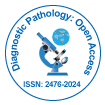Commentary on Extra Nodal Extension (ENE) in Node Positive Breast Cancer
Received: 08-May-2024 / Manuscript No. DPO-24-134362 / Editor assigned: 10-May-2024 / PreQC No. DPO-24-134362 (PQ) / Reviewed: 24-May-2024 / QC No. DPO-24-134362 / Revised: 31-May-2024 / Manuscript No. DPO-24-134362 (R) / Published Date: 07-Jun-2024 DOI: 10.4172/2476-2024.9.2.233
Description
The presence of Extra Nodal Extension (ENE) in lymph node positive breast cancer patients was found to be associated with worse prognosis and additional nodal involvement in the 1970s [1]. Since then, many more studies have confirmed these findings [2,3]. In 2016, The College of American Pathologists (CAP) recommended pathologists to report ENE as "present or absent" for all node positive breast cancer in their pathology report. More recently, studies have shown that not only the presence of ENE is important for the prognosis of breast cancer, but also the extent of ENE is also important for these patients, with larger ENE associated with worse prognosis and increased number of nodal metastasis in turn, these patients need additional local treatment, namely axillary radiation therapy [4,5]. Because of these studies, in 2022, CAP made additional recommendation on ENE reporting, adding the size requirement for ENE in pathology report, recommending to use "ENE: Absent or present <2 mm or present >2 mm" in the report.
ENE, defined as metastatic tumor cells penetrating through the capsule of a lymph node into the perinodal tissue, is largely understood and agreed upon among pathologists around the world. However, the valuation and reporting of ENE are not, which have been clearly demonstrated by an international survey conducted by us a few years ago [6]. We found that although the great majority of pathologists document ENE in their pathology reports, and some even report the size of the ENE, how to measure the size of ENE however, was not uniform. There are two major subgroups: 47% of the pathologists measure the largest dimension of the ENE regardless of its direction, while another 30% of the pathologists measure the largest perpendicular distance from the capsule (invasive front) for the ENE. This finding is consistent with our clinical experience and with studies in current literation. In practice, we understand that for any given breast cancer, these two most common measurements–the largest dimension regardless of its orientation and the largest distance of invasive front perpendicularly from the capsule of a lymph node, are most often very different, with perpendicular distance being significantly smaller than that of the largest size in any direction. It is generally believed that perpendicular measurement of the ENE may be more reflective of the tumor biology/aggressiveness of the tumor. Bullock et al have proposed to use perpendicular measurement of the ENE for head and neck tumors [7]. The recommendation on reporting the ENE size from CAP has generated confusion among pathologists, since no recommendation on how to measure its size was given in its recommendation. Until there is a standardized method on ENE measurement, the utility of the size of ENE in pathology report to guide clinical decision should be taken with great caution.
In addition to the lack of standardization on how to measure the size of ENE among practicing pathologists, we also found that in our survey the diagnosis of ENE is not without challenges [6]. Many factors can affect the accuracy in diagnosis of ENE, which includes the presence of perinodal Lympho Vascular Invasion (LVI), the lack of capsule integrity, and the presence of fatty hilar or fatty replacement of a lymph node, all of which can make the accurate diagnosis of ENE difficult. These difficulties in diagnosis add another level of challenges when using ENE to guide clinical treatment.
Finally, two other critical questions remain. First, is the arbitrary cutoff value of 2 mm really necessary for ENE reporting? A report has shown that while the presence or absence of ENE had clinical significance, the 2 mm cutoff did not [8]. Secondly, what is the best cutoff value? Aziz, et al. reported that a 3 mm perpendicular measure, not a 2 mm has clinical significance [9]. These studies suggest that further multi-institutional perspective studies are needed to define the clinically meaningful cutoff value if needed for ENE in breast cancer patients.
Acknowlegment
The author wish to thank Ms. Lora Xu for her patience and careful editing of this manuscript
References
- Mambo NC, Gallager HS. (1977) . Cancer 39: 2280-2285.
[] [] []
- Leonard C, Corkill M, Tompkin J, Zhen B, Waitz D, et al. (1995) . J Clin Oncol 13: 47-53.
[] [] []
- Neri A, Marrelli D, Roviello F, Stefano AD, Guarnieri A, et al. (2005) . Ann Surg Oncol 12: 246-253.
[] [] []
- Choi AH, Blount S, Perez MN, Paz CEC, Rodriguez SA, et al. (2015) . JAMA Surg 150: 1141-1148.
[] [] []
- Gooch J, King TA, Eaton A, Dengel L, Stempel M, et al. Ann Surg Oncol 21: 2897-2903.
[] [] []
- Tang P, Moravek M, Oprea-Ilies G, Mon KS, Pambuccian SE. (2022) . Pathol Res Pract 237: 154060.
[] [] []
- Bullock MJ, Beitler JJ, Carlson DL, Fonseca I, Hunt JL, et al. (2019) . Arch Pathol Lab Med 143: 452-462.
[] [] []
- Yang Z, Ma XX, Yang W, Shui R. (2020) Scinentic reports10: 14682.
[] [] []
- Aziz S, Wik E, Knutsvik G, Klingen TA, Chenet Y, et al. (2017) . PLoS One. 12: e0171853.
[] [] []
Citation: Tang P (2024) Commentary on Extra Nodal Extension (ENE) in Node Positive Breast Cancer. Diagnos Pathol Open 9: 233. DOI: 10.4172/2476-2024.9.2.233
Copyright: © 2024 Tang P. This is an open-access article distributed under the terms of the Creative Commons Attribution License, which permits unrestricted use, distribution, and reproduction in any medium, provided the original author and source are credited.
Share This Article
黑料网 Journals
Article Tools
Article Usage
- Total views: 319
- [From(publication date): 0-2024 - Mar 10, 2025]
- Breakdown by view type
- HTML page views: 260
- PDF downloads: 59
